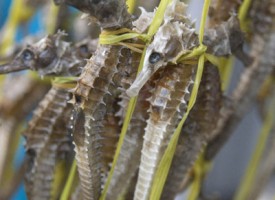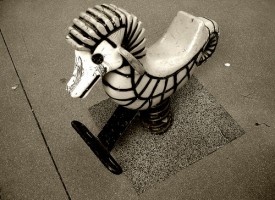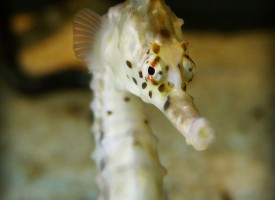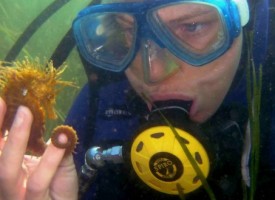 A question I get asked a lot is ‘Are seahorses endangered?’. And my answer, sadly, is yes.
A question I get asked a lot is ‘Are seahorses endangered?’. And my answer, sadly, is yes.
So, what can we do about it? Well, here are my top ten tips for doing your bit to save the seahorses:
1. Don’t buy dead seahorses
 This may sound a little odd. Why would you want a dead seahorse?
This may sound a little odd. Why would you want a dead seahorse?
Because they’re beautiful, I guess. Seahorses cover themselves in an overcoat of bony plates – instead of a more conventional suit of fishy scales – which means they keep much of their delicate and intricate shape after they die.
But don’t forget it is just the dead body of a fish that once led a quiet, gentle life on the sea floor.
Picking up a dead seahorse from the beach isn’t so bad. But the ones on sale in seaside souvenir shops were probably grabbed live from the sea. So please, don’t buy them. The seahorses will thank you.
2. Don’t buy seahorse medicines
 Again, this might sound odd…
Again, this might sound odd…
Especially to anyone who isn’t familiar with the widespread practice of using seahorses as traditional medicines.
Every year at least 25 million seahorses are taken from the sea (and probably a whole lot more than that – no one is really counting), and a driving force behind the seahorse trade is demand for Traditional Chinese Medicines. 500 year-old texts prescribe seahorses for all sorts of conditions from broken bones and bed wetting, to skin rashes and even a flagging libido.
Especially worrying is the growing popularity of pre-packaged, off-the-shelf seahorse medicines.
So, if you do use traditional medicines and can afford to buy seahorses (they aren’t cheap), then think about engaging your compassion for the natural world and choose an alternative that doesn’t include endangered species. Because there are plenty of alternatives (try Viagra).
3. Make sure your pets were born on a farm
It’s not up to me to say if people should or shouldn’t keep seahorses as pets (although I can see how lovely it would be to have beautiful seahorses in my life every day). And these days, if you want them, you can buy live seahorses that were bred in captivity and not taken from the wild.
In Poseidon’s Steed I look into the pros and cons of keeping seahorses: for you, for the seahorses, and for the environment. And in a recent episode of the Naked Oceans podcast I visited a seahorse breeding lab in Florida to find out how it’s done.
4. Protect the seahorses’ world 
All sorts of human activities threaten the places seahorses call home including coral reefs, seagrass meadows, mangroves, and estuaries. The list of problems is long and growing and includes pollution, habitat destruction, and climate change.
And these are all things to worry about and take action over. Especially important is the creation of marine reserves – places where the destructive influence of humankind is minimised.
Currently less than 1% of the oceans are offered protection from human activities. That number needs to go up – a lot.
You may not have the power to set up your own marine reserve (who does?) but public support for local, regional, national and international campaigns to protect the oceans is vital for action.
 5. Stamp out destructive fishing
5. Stamp out destructive fishing
Shrimp trawl boats don’t only catch shrimp but they also scrape up millions of seahorses every year (most seahorses made into traditional medicines are picked out of trawl nets). This insensitive, unselective form of fishing has to stop.
Do your bit by not buying seafood that was caught in trawlers.
How do you know, you cry? Well, you can ask.
More and more these days, supermarkets and restaurants are giving customers information about how their fish is caught. If they don’t say and won’t tell you, then don’t buy.
Check out Monterey Bay Aquarium’s new Super Green List of fish that are good for you and not so bad for the oceans.
6. Take a stand against climate change
 It’s true that we release carbon dioxide into the atmosphere – that huge, gassy space above our heads – but a lot of it ends up in the oceans where it’s already wreaking a particular brand of marine catastrophe. The oceans are becoming more acidic. And the seahorses – along with so many other marine creatures – will get hit hard, mainly because lots of them live in places that may soon be gone: coral reefs.
It’s true that we release carbon dioxide into the atmosphere – that huge, gassy space above our heads – but a lot of it ends up in the oceans where it’s already wreaking a particular brand of marine catastrophe. The oceans are becoming more acidic. And the seahorses – along with so many other marine creatures – will get hit hard, mainly because lots of them live in places that may soon be gone: coral reefs.
Curbing carbon dioxide emissions matters, especially if you like the idea of a world with seahorses and coral reefs and other beautiful extraordinary wildlife.
And we can all do our bit to help. Switch off lights, turn down thermostats, wear a sweater, insulate your house, recycle, drive less, fly less, ride your bike more, walk to the park. Get involved in campaigns like 350.org. And think of the seahorses while you do it.
7. Go see the seahorses
 Aquariums around the world are home to thousands of seahorses and more of them than ever are bred in captivity (many aquariums swap baby seahorses when they have too many, which is often the case for the species that breed happily in tanks).
Aquariums around the world are home to thousands of seahorses and more of them than ever are bred in captivity (many aquariums swap baby seahorses when they have too many, which is often the case for the species that breed happily in tanks).
Next time you visit an aquarium, stop for a few minutes and watch the seahorses doing their seahorse thing and let your thoughts wander off. When they come back, you’ll have your own personal seahorse moment to carry with you and remind you about these amazing creatures and the wild world they live in.
8. Go dive for seahorses
 If you are an addict of the underwater world like me, then there are heaps of places to go see a seahorse. Well, you can try anyway: they are extremely tricky to spot, with their cunning camouflage and shy nature.
If you are an addict of the underwater world like me, then there are heaps of places to go see a seahorse. Well, you can try anyway: they are extremely tricky to spot, with their cunning camouflage and shy nature.
Divers can play an important role in proving that a seahorse is worth more in the water than out. So, go out and support dive operations that care about their local seahorses.
And if you do spy a seahorse, please don’t hassle it, poke it, prod it, or blind it with camera flash.
In this picture I am holding onto Troy (or rather, he is holding on to me), but I must point out, I was diving with a licensed seahorse researcher (the UK species are now protected). We were conducting a survey, taking down this guy’s vital statistics, and stopped just quickly for an unmissable photo op.
Check out chapter 6 of Poseidons’ Steed for more of my seahorse spotting tips.
9. Send in your seahorse sightings
Do your bit for seahorse research by getting involved with local seahorse spotting projects. The British Seahorse Survey collects reports of seahorse sightings from across the British Isles – and that goes for live seahorses in the water and dead seahorses too.
10. Spread the seahorse love
 And finally… I recently discovered these gorgeous cuddly seahorses made by brilliant artist/designer snaulkter.
And finally… I recently discovered these gorgeous cuddly seahorses made by brilliant artist/designer snaulkter.
They are simply the most adorable – and accurate – depictions of seahorses in fabric that I’ve seen (and I love that they are made from reused, ‘upcycled’ materials). Perfect!
So go get the kids hooked on seahorses, or indulge a grown up’s passion. Each seahorse is a unique critter, and each one is beautiful.
This post first appeared at wildoceanblue.
Photos by luv life, Helen Scales, Jiangang Luo/Marine Photobank, Marine Conservation Cambodia/Marine Photobank, Elston, Islodelba, Tassiesim, Steve Trewhella
Leave a Reply